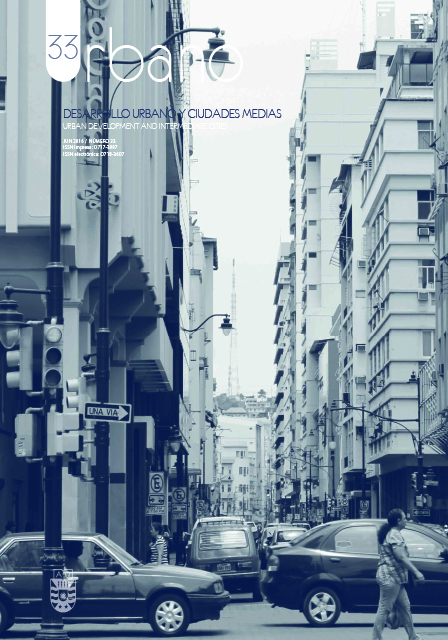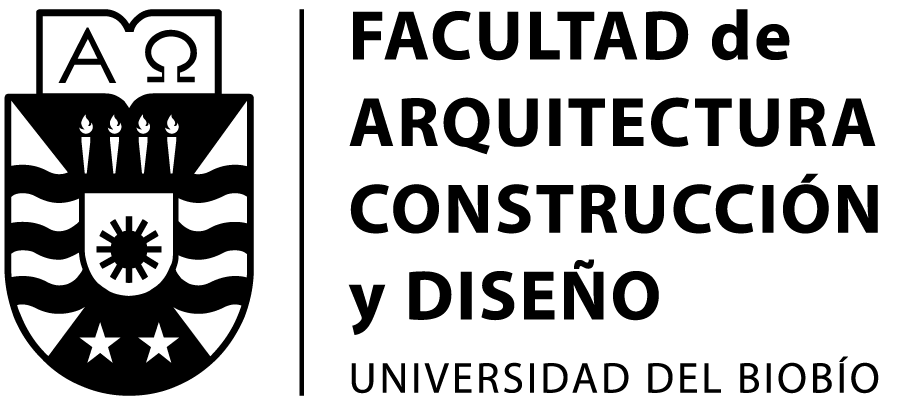The evolution of Valdivia after the earthquake of 1960: Approaches, scalar factors and determinants
Keywords:
intermediate cities, urban expansion, ValdiviaAbstract
The rapid urbanization of southern hemisphere cities is placing them on the frontline of the 21st century development agenda. Intense transformation processes pose both challenges and opportunities to think and act on the future of cities. In Latin America, these processes have increased the scale of the urban environment, with intermediate cities as the main protagonists. In Chile, they exhibit accelerated socio-spatial changes, thus revealing urban expansion and physico-environmental degradation in their downtowns. In the case of Valdivia, an economic, political and morphological approach is used to explore factors and determinants that have influenced its expansion since the earthquake of 1960. The results reveal that current urban policies and planning instruments have encouraged and transferred to the private sector the responsibility of shaping urban growth through new expansive and low density developments towards the peripheries. This has generated profound changes in the territory and exacerbated socio-spatial segregation in cities.
Downloads
References
ALMONACID, Fabián. Valdivia 1870-1935: Imágenes e historias. Valdivia: Universidad Austral de Chile, 1998.
AZÓCAR, Gerardo; SANHUEZA, Rodrigo; HENRÍQUEZ, Cristián. Cambio en los patrones de crecimiento en una ciudad intermedia: el caso de Chillán en Chile Central. EURE (Santiago), 2003, vol. 29, no 87, pp. 79-82.
BAESSOLO, José Ignacio; FUENTES Eduardo. Cronología y catastro de industrias en Valdivia, una mirada a nuestro pasado industrial. El legado alemán y su influencia en la industria. Valdivia conecta. [En línea]. 2011. [Consultado 21 de Julio 2016], Disponible en http://valdivia-conecta.blogspot.com
BATTY, Michael. Cities and complexity: understanding cities with cellular automata, agent-based models, and fractals. The MIT press, 2007.
BID. Valdivia: Capital Sostenible. Plan de Acción. Banco Interamericano de Desarrollo. Iniciativa ciudades emergentes y sostenibles. Ilustre Municipalidad de Valdivia. [En línea]. 2013. [Consultado 21 de Julio 2016], Disponible en http://www.iadb.org/es/temas/ciudades-emergentes-y-sostenibles/plan-de- accion-de-valdivia-chile,19095.html
BORSDORF, Axel. El desarrollo urbano de Valdivia: estudio de caso en una ciudad mediana. Innsbruck, Austria: Instituto de Geografía de la Universidad de Innsbruck, Espacio y Desarrollo, 2000, n° 12, pp. 45-81.
BORSDORF, Axel. Cómo modelar el desarrollo y la dinámica de la ciudad latinoamericana. EURE. 2003, vol. 29, no 86, pp. 37-49.
BUCHANAN, Mark. Small world: uncovering nature’s hidden networks. London: Phoenix, New ED edition. 2002.
CA VALDIVIA. Opinión del Colegio de Arquitectos Valdivia respecto del Nuevo Plan Regulador Comunal de Valdivia (PRCV). [En línea]. 2013. [Consultado 21 de Julio 2016] Valdivia, Chile: Escuela de Arquitectura, UACh. Disponible en: http://bit.ly/1uMvviu
CANIGGIA, Gianfranco; MAFFEI, Gian Luigi. Architectural composition and building typology: Interpreting basic building. Florencia: Alinea, 2001.
CASTAEDO, Leopoldo. La Hazaña del Riñihue, el terremoto de 1960 y la resurrección de Valdivia. Santiago de Chile: Editorial Sudamericana, 2000
DE MATTOS, Carlos A.. Santiago de Chile, globalización y expansión metropolitana: lo que existía sigue existiendo. EURE. 1999, vol. 25, no 76 pp. 29-56.
DOEVENDANS, Kees; SCHRAM, Anne. Creation/accumulation city. Theory, Culture & Society, 2005, vol. 22, no 2, p. 29-43.
ESPINOZA, Daniel. Expansión urbana descontrolada en las ciudades intermedias: el caso particular de Valdivia. ¿Qué factores han influido en la expansión de la ciudad? Seminario de investigación. FAU Universidad de Chile. 2014
FREY, Hildebrand. Designing the city: towards a more sustainable urban form. Londres: E &FN Spon, 1999.
FREY, Hildebrand; BAGAEEN, Samer. Adapting the City. En JENKS, Mike; JONES, Colin (ed.). Dimensions of the sustainable city. Springer Science & Business Media, 2010, pp. 163-182.
GARCÍA VÁZQUEZ, Carlos. Antípolis: el desvanecimiento de lo urbano en el Cinturón del Sol. Palimpsesto, 2011, no 2, p. 10-11.
GEHL, Jan. La humanización del espacio urbano: La vida social entre los edificios. Barcelona: Reverté. 2006.
GUARDA, Gabriel. Nueva historia de Valdivia. Santiago de Chile: Ediciones Universidad Católica de Chile, 2001.
VALDIVIA Y SU EVOLUCIÓN POST-TERREMOTO 1960: ENFOQUES, FACTORES ESCALARES Y CONDICIONANTES DANIEL ESPINOZA GUZMÁN, ANTONIO ZUMELZU SCHEEL REVISTA URBANO No 33 / MAYO 2016 PÁG.14 - 29 ISSN 0717 - 3997 / 0718-3607
HÉNAFF, Marcel; FEENBERG, Anne-Marie. Of stones, angels and humans: Michel Serres and the global city. SubStance, 1997, vol. 26, no 2, p. 59-80.
HILLIER, Bill; HANSON, Julienne. The social logic of space. Cambridge: Cambridge university press, 1989.
HILLIER, Bill. Space is the machine: a configurational theory of architecture. Cambridge: Cambridge University Press. 2007.
HILLIER, Bill. Centrality as a process: accounting for attraction inequalities in deformed grids. Urban Design International, 1999, vol. 4, no 3-4, p. 107-127.
INOSTROZA, Luis; BAUR, Rolf; CSAPLOVICS, Elmar. Urban sprawl and fragmentation in Latin America: A dynamic quantification and characterization of spatial patterns. Journal of environmental management, 2013, vol. 115, p. 87-97.
INZULZA, Jorge; GALLEGUILLOS, Ximena. Latino gentrificación y polarización: transformaciones socioespaciales en barrios pericentrales y periféricos de Santiago, Chile. Revista de geografía Norte Grande, 2014, no 58, p. 135-159.
LÓPEZ, Patricio. Las Administraciones municipales en la historia de Valdivia. Valdivia: Dokumenta Comunicaciones. 2009
KÄRRHOLM, Mattias. The scaling of sustainable urban form: A case of scale- related issues and sustainable planning in Malmö, Sweden. European Planning Studies, 2011, vol. 19, no 1, p. 97-112.
LUNGO, Mario. Urban sprawl and land regulation in Latin America. Land Lines, 2001, vol. 13, no 2, p. 91-113.
MATTOS, Carlos A. de. Santiago de Chile de cara a la globalización:¿ otra ciudad?. Revista de Sociología y Política, 2002, vol. 19, p. 31-54.
MINVU. Modifica Plan Regulador Comunal de Valdivia. Diario Oficial de la República de Chile, 1988, p.5.
MONTES, Carlos. A 20 años de la liberalización de los mercados de suelo. Revista de Urbanismo, 1999, no 1, pp. 1-7.
ONU-HABITAT. Estado de las ciudades de América Latina y el Caribe 2012. Rumbo a una nueva transición urbana. Nairobi: Programa de las Naciones Unidas para los asentamientos humanos, 2012.
PATTEE, Howard H. Hierarchy theory: the challenge of complex systems. Nueva York: Braziller, 1973.
PORTA, Sergio; CRUCITTI, Paolo; LATORA, Vito. The network analysis of urban streets: a primal approach. Environment and Planning B: planning and design, 2006, vol. 33, no 5, p. 705-725.
SABATINI, Francisco. Reforma de los mercados de suelo en Santiago, Chile: efectos sobre los precios de la tierra y la segregación residencial. EURE, 2000, vol. 26, no 77, p. 49-80.
SALTHE, Stanley N. Self-organization of/in hierarchically structured systems. Systems Research, 1989, vol. 6, no 3, p. 199-208.
UN HABITAT, Global report on human settlements 2011: cities and climate change. Nairobi: United Nations Human Settlements Program, Earthscan, 2011.
ZUMELZU, Antonio. Sustainability as a global problem in the carbon era: Eindhoven as an example of anthropocene city. Revista AUS, 2011, no 10, p. 4-7.
ZUMELZU, A. Centrality and urban transformation: An exploration of the process of live centrality in water. 2014.
Downloads
Published
How to Cite
Issue
Section
License
The content of articles which are published in each edition of Habitat Sustentable, is the exclusive responsibility of the author(s) and does not necessarily represent the thinking or compromise the opinion of University of the Bio-Bio.
The author(s) conserve their copyright and guarantee to the journal, the right of first publication of their work. This will simultaneously be subject to the Creative Commons Recognition License CC BY-SA, which allows others to share-copy, transform or create new materials from this work for non-commercial purposes, as long as they recognize authorship and the first publication in this journal, and its new creations are under a license with the same terms.![]()























